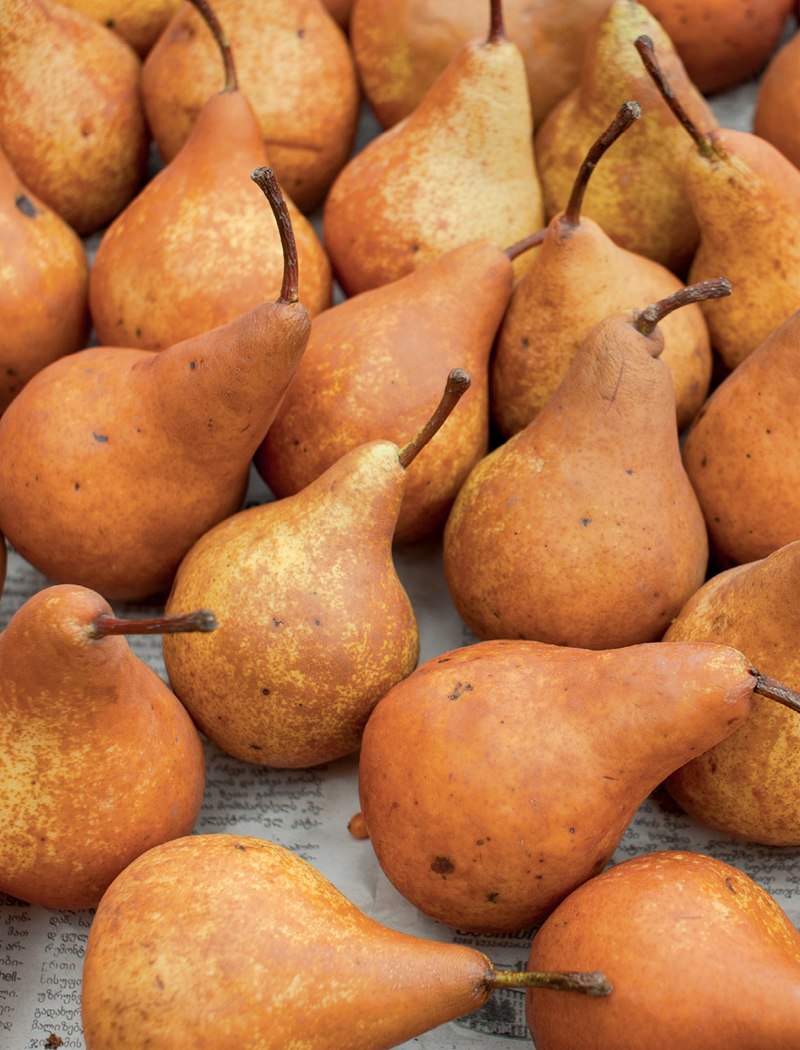

Tbilisi, Georgia—Autumn in the markets of the Caucasus means ripe pears.
Of all that I learned and marveled at on my first trip to Georgia for this book, twenty-four years after I’d been there in the Soviet era, it was the fruit that dazzled me the most.
The markets in Georgia were full of fresh and dried fruits, and gardens were filled with fruit and nut trees. On later trips to Iran, Armenia, Kurdistan, and Azerbaijan, I learned that throughout the region, at least in rural areas and small towns, family larders are a treasure-house of preserved fruits.
Cooks in the Caucasus, Iran, and Kurdistan have a deep understanding of the value of fruit. Most is used to make delicious syrups and juices, or preserved in a variety of other ways. Moraba—sometimes written “muraba”—is the word all over the Persian culinary region for fruit preserved in syrup like thick jam (see Apricot Moraba and Carrot Moraba).
The other Persian-world knockouts in the fruit department are kompot and sharbat. Here kompot means a fruit-flavored liquid, made of fresh fruit that steeps in water with a little sugar, leaching its lovely flavor into the water. In other words, it’s a kind of slow-motion fruit tea (see recipes here and here). Sharbat is the word for a category of Persian drinks made with sweet fruit syrups diluted with water and served over ice (see recipes here through here).
People in the region also preserve fruit by drying it whole, or by cooking it down to make a puree and then drying it in thin sheets to make fruit leather, probably the earliest and simplest way of storing fruit over winter (see recipe). Tart dried fruits and fruit leathers are an ingredient in many savory dishes. All these inventive ways of preserving fruit mean that in the cold of winter, families have foods to eat that evoke the intense ripe flavors of summer. They’re life-giving emotionally as well as culinarily.
Winemaking may have come before all these methods of preserving fruit. It certainly came early; archaeological finds confirm that the ancestors of Georgians and Armenians were making wine thousands of years ago. In fact, the species of wild grape that is the ancestor of modern wine grapes is native to the Caucasus.
In Georgia and Armenia, many people still make wine at home, using traditional “natural” wine methods (see Wine in the Caucasus). They also make cha-cha, a kind of grappa-like liquor.
In Iran, some people make homemade liquor from raisins, a drink that’s known as aragh or arak.
In Georgia, Armenia, and Azerbaijan, liquor distilled from other fruits and from grains is often referred to as vodka; that made from mulberries (tut in all the languages of the region; see Mulberry Country) is known as tutovka. Tutovka is often homemade and is usually drunk straight, chased with homemade or store-bought sour cherry juice or another tart-sweet fruit juice.
Rolls and folded sheets of fruit leather of all types and colors are sold in markets throughout the Persian culinary region, but many home cooks in the countryside still make their own. The Persian word for fruit leather is lavashak; in Georgian, it’s tklapi; in Azeri, lavashana; in Armenian, basteigh or basteil; and in Kurdish, nan qesi. This may well have been the earliest way that the people here preserved fruit. It requires no sugar, no jars or special containers—just a pot to cook the fruit and a flat surface where it can be spread to dry. The leather is important as a way of storing fruit flavor and intensity for use in the winter months.
My favorites are the unsweetened sheets of sour plum or sour cherry. I love their tart edge and intense flavor. Tart fruit leathers (e.g., sour plum, sour cherry, apricot) are used as flavorings in savory dishes; sweeter ones (e.g., peach and kiwi) are eaten as a snack.
Make this when stone fruits are plentiful and in season. You will need a heavy pot for cooking the fruit down, a blender or food processor for reducing it to a smooth puree, and some parchment paper–lined baking sheets for it to dry on.
The pureed fruit gets spread onto the parchment paper to dry. Then it can be stored for up to 6 months.
10 pounds plums, apricots, peaches, or nectarines, halved and pitted, or cherries, pitted
About 1 cup water
Sugar or honey (optional)
Place the fruit in a large heavy pot, add the water, cover, and bring to a boil over medium heat. Reduce the heat and cook at a low boil, stirring occasionally, until the fruit has completely softened and broken down, 15 to 20 minutes. Taste and decide if you want to add some sugar or honey. If you do, stir it in and cook the fruit a little longer to blend the flavors. Set aside to cool.
Working in batches, process the fruit in a food processor or blender to a smooth puree. Transfer to a wide bowl.
Line several baking sheets with parchment or wax paper. Pour the fruit puree onto the paper, spreading it to leave a small margin all around; it should be about ¼ inch thick, no more. Set out in the hot sunshine to dry, loosely covered with cheesecloth or a cotton cloth. Or, if you are in a rush or lack hot sun, heat your oven to about 160°F to dry the fruit. Leave it for about 5 hours, opening the oven door occasionally to check on it and let out humidity, until dry and no longer sticky. (You’ll notice that it shrinks as it dries.)
Rather than storing the large sheets, it’s more practical to cut the fruit sheets into long strips 2 to 3 inches wide. Peel off the paper backing (sometimes it’s stuck on), then place the fruit sheets back on the paper and cut the fruit and paper into strips. Loosely roll up the strips (the paper backing helps ensure that the fruit doesn’t stick to itself) and store away from sun and heat in well-sealed plastic bags or other containers for up to 6 months.
West of Baku, Azerbaijan—Very near to the beekeeper pictured here, I came upon a man selling rounds of fruit leather he pinned up on a clothesline. They glowed like pieces of thick stained glass as they waved and fluttered in the breeze.
Churchkhela • Kaghstr Sajukh • Sujukh

Tbilisi, Georgia—Walnuts and hazelnuts are threaded on strings, then dipped in thick fruit syrup to make churchkhela. In the foreground are strings of apples.
In autumn, when it was time to harvest grapes, walnuts, and hazelnuts, households in Armenia, Georgia, and Azerbaijan traditionally stored part of that harvest in the form of these odd, bumpy-looking “fruit candles.” Nowadays, with more people living in towns and cities, most churchkhela are made in quantity by specialists and sold in markets.
The process of making it involves stringing the shelled nuts on a thread and dipping them into doshab (see Glossary), the thickened grape juice that’s yet another use for the grapes of the region. They’re dipped many times, with pauses for each layer to cool and set a little before dipping again (like making candles). It’s a brilliant storage method. The doshab acts like the fat in a confit: It seals in the nuts, thus preventing them from going rancid as well as protecting them from pests.
The “candles” are a treat to be sliced and enjoyed in the winter months. They also make great traveling food.
The doshab that’s used in Armenia for making kaghstr sajukh is generally thickened with a lot of flour or cornstarch. (Sajukh means sausage, so these sausage-looking items are called “sweet” [kaghstr] sajukh.) In Georgia, much less thickener is used. The result is that the Georgian churchkhela have a sharper, more direct flavor, while the Armenian versions are milder and more muted in taste.
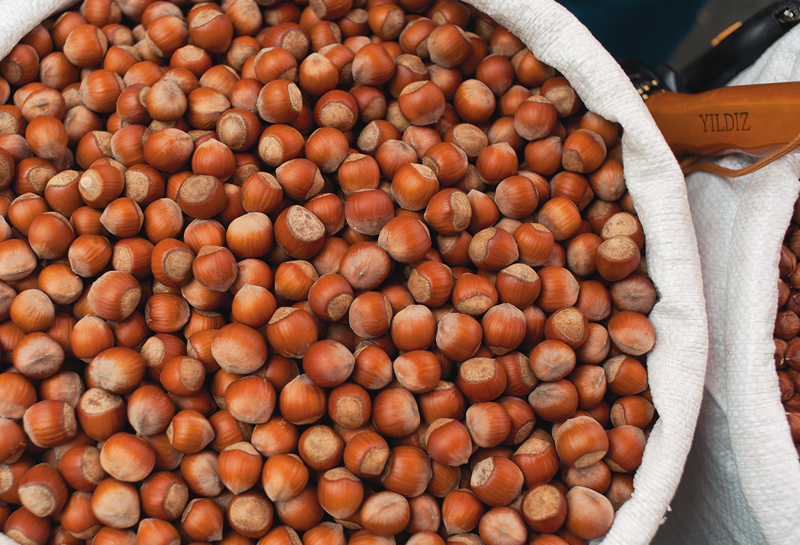
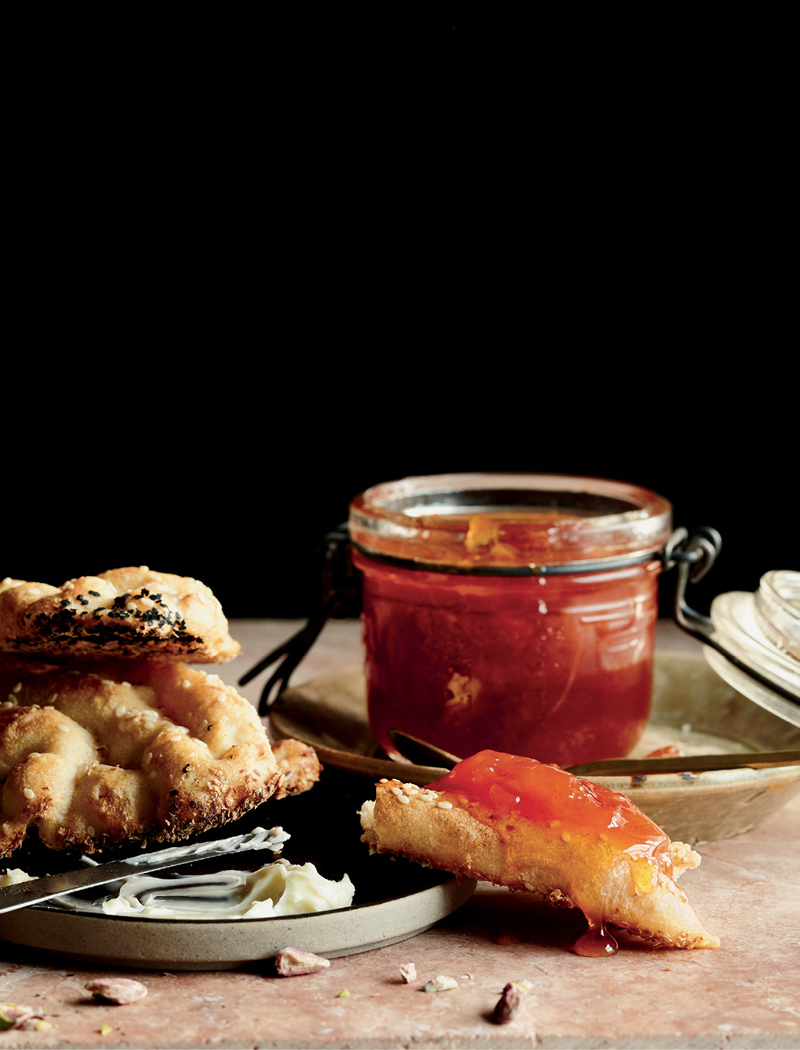
Apricot Moraba on homemade Persian Barbari Bread (see recipe).
In the attractive town of Sheki, tucked against the Caucasus Mountains in western Azerbaijan, I was served apricot moraba—a thick jam, called aritch merabese in Azeri—with tea. You take a sip of tea and then a little jam on a spoon as a sweet accompaniment.
You’ll notice that this recipe calls for very little water, and that the pot is shaken to mix the jam, rather than stirred with a spoon, so that the apricots keep their shape instead of turning to mush. The whole process is more like candying apricots. The basic proportions are 1 pound sugar and a scant ⅓ cup water per pound of pitted fruit. You will need a scale, a canning funnel, and canning jars.
Makes about 10 pints
About 7 pounds fresh apricots, halved and pitted
1 teaspoon baking soda
About 6½ pounds sugar
2 cups water
3 tablespoons fresh lemon juice or 1 teaspoon citric acid (see Glossary)
Place the apricots in a large pot and add water to cover. Add the baking soda and stir to dissolve it. Let the fruit stand for 30 minutes.
Drain the apricots in a colander, rinse thoroughly, and drain again. Weigh the fruit, then measure out the same weight of sugar.
Pour the 2 cups water into a large heavy nonreactive pot, add the sugar, and place over medium-high heat. Bring to a boil, stirring to dissolve the sugar (the mixture will be very thick). Add the apricots and shake the pot; do not stir. Bring back to a boil and boil for 10 minutes, shaking the pot occasionally. The syrup will foam up; lower the heat as necessary to prevent it from boiling over. Remove from the heat and use a heatproof spatula to scrape down the sides of the pot; otherwise, you will have a rim of crystallized sugar. Let stand for 10 minutes.
Put the pot over the heat and bring back to a boil, again shaking the pot rather than stirring. Boil for 15 minutes, shaking the pot occasionally. Remove from the heat and set aside to rest, covered loosely with cheesecloth, not a lid (the idea is that some of the water will evaporate). If the day is very dry, a 3- to 4-hour rest will be sufficient; if it is very humid, then let the moraba rest for 6 to 10 hours.
Sterilize ten 1-pint jars or twenty ½-pint jars, rings, lids, a canning funnel, and a ladle: Put them through a hot wash in a dishwasher, or wash them thoroughly in very hot soapy water and rinse well in hot water. Set them on a tray and place in a 200°F oven to air-dry.
Bring the moraba to a boil over medium heat, shaking the pot to prevent sticking, then shake the pot frequently as the moraba boils gently for 15 minutes. To test the moraba, drizzle a small spoonful on a cold surface. It should be thick, not runny. If it is not, cook for 5 to 10 minutes longer and retest.
Stir in the lemon juice or citric acid and cook for another minute. Remove from the heat.
Using the funnel, ladle the moraba into the clean, dry jars. Put on the lids and rings, but don’t fully tighten the rings; let cool until you hear the lids pop (meaning they’ve sealed). Remove the rings and wipe the tops of the jars well. Replace the rings and tighten them. Label the jars and store in a cool, dark place for up to 1 year.

Left: Tatev, Armenia—A classic Armenian breakfast of flatbread, tea, apricot moraba, butter, and crumbled white cheese.
Right: Outside Sulaymaniyah, Kurdistan—The Persian love of picnics is a feature of Kurdish culture. Here at a festival out in the country, a teapot and a kebab rest on the still-hot embers of a small wood fire.
The sweetness of carrots makes them ideal for moraba. Carrot moraba is a delicious very sweet Persian preserve that is traditionally flavored with cardamom and rose water. There’s a lively citrus note from lemon zest and juice. Serve this as a spoon jam (see Glossary) or a sweet taste on a spoon, or use as you would any jam.
Makes 2 cups
1 pound carrots, preferably organic, peeled
1 large or 2 small lemons, preferably organic
1 cup water
2 cups sugar
5 cardamom pods, lightly crushed
1 tablespoon rose water
Sterilize two 1-cup jars, rings, lids, and a spoon or ladle: Put them through a hot wash in a dishwasher, or wash them thoroughly in very hot soapy water and rinse well in hot water. Set them on a tray and place in a 200°F oven to air-dry.
Shred the carrots on a box grater; you should have about 4 cups. Set aside.
Use a Microplane or a fine grater to zest the lemon(s). Set the zest aside.
Squeeze the juice from the lemon(s) (you should have about 3 tablespoons) and set aside.
Pour the water into a large heavy pot, add the sugar, and bring to a boil, stirring to dissolve the sugar. Add the zest and cardamom pods and boil for 10 minutes, then add the carrots and cook at a strong boil until they are softened and reduced to a tender thick mass, 12 to 15 minutes.
Add the lemon juice and the rose water, stir, and simmer for another minute.
Ladle the carrots and syrup into the clean, dry jars, distributing the liquid and solids evenly. Put on the lids and rings, but don’t fully tighten the rings; let cool until you hear the lids pop (meaning they’ve sealed). Remove the rings and wipe the tops of the jars well. Replace the rings and tighten them. Label the jars and store in a cool, dark place for up to 1 year.
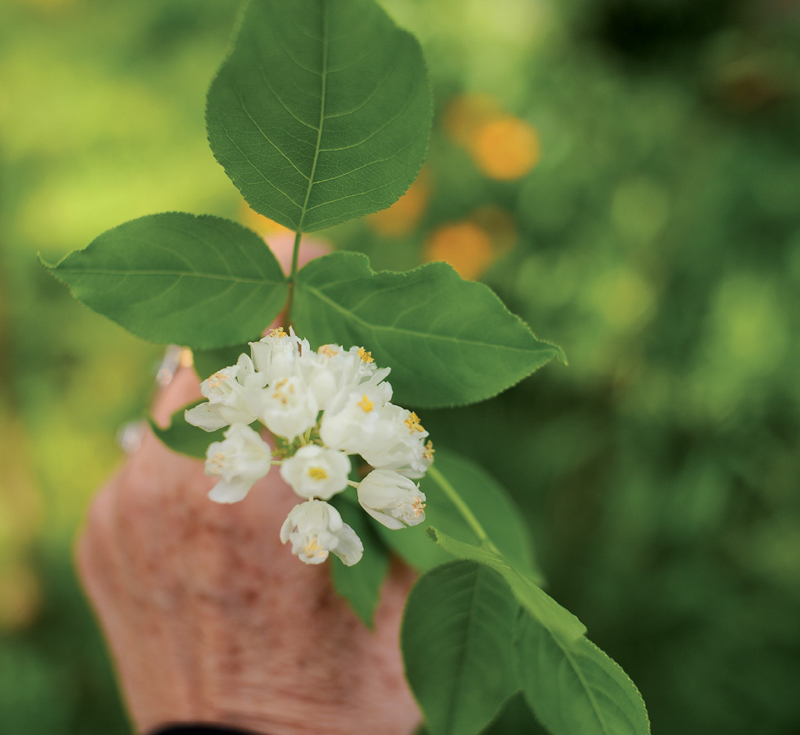
Kutaisi, western Georgia—Apple blossoms in Dodo’s amazing garden.
Elene’s grandmother Dodo is a slender woman in her nineties, stylish, intelligent, and entertaining. She lives in the family house in Kutaisi with her widowed daughter, her other granddaughter, and her jars of preserves, ready to welcome visitors. She inhabits the present as well as multiple layers of the past, and wanders through the layers, alighting now here, now there. Because her life has been full of drama, with grand highs and tragic lows, at one moment she might be laughing with remembrance about the fur coat she wore when she visited Moscow with her husband before the Second World War, and the next minute weeping about the loss of her son by drowning.
The first kompot I ever tasted was at Dodo’s house. She went to the cupboard and lugged over a very large sealed jar of peaches, pausing for us to admire it. The whole peaches were smooth globes, pale yellow tinted with pink. She unscrewed the lid and, with a small dipper, lifted out some liquid and poured it into a narrow glass. It was a tender pink, and tasted like I imagine the nectar of the gods might taste, lightly sweet, heavenly.
Dodo smiled with satisfaction at the blissed-out look on my face. She’d scored a hit, but of course she had never doubted that she would.
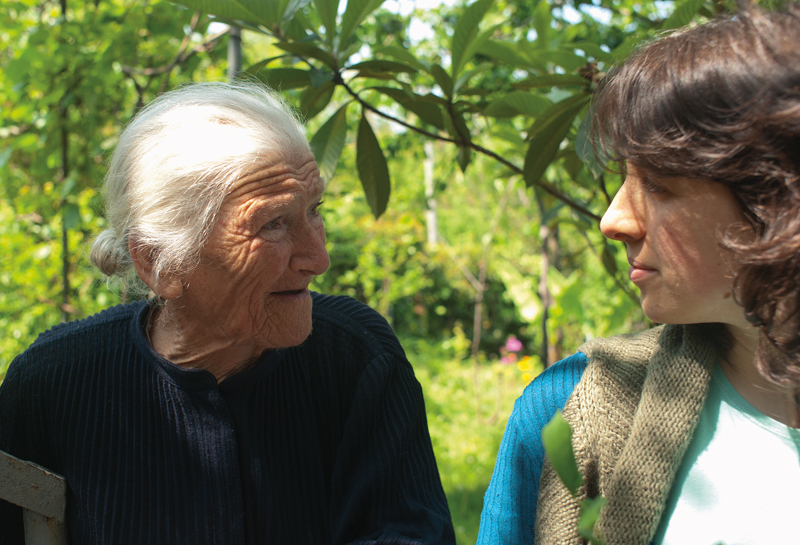
Dodo and her granddaughter Elene in the garden near the house.
Kompot is the word used in Armenia, Azerbaijan, and Georgia for juices made from ripe fruit that has been steeped in hot water with a little sugar. Kompots are a treat in the cold months, a reminder of summer.
The summer after my first trip to Georgia for this book, the peaches in Toronto were fabulous. The peach kompot I had tasted in Georgia, made by Elene’s grandmother (see Kutaisi Grandmother), was my inspiration for this recipe.
Get all your canning equipment ready first, and follow the canning instructions. Because the acidity of peaches is high, they don’t need a very long boil in the canner, unlike lower-acidity foods.
Makes 3 quarts
One 6-quart basket of peaches (about 10 pounds)
Sugar: 1 cup sugar per quart jar; ½ cup sugar per pint jar
A canner, or very large tall pot at least 4 inches taller than your jars
A rack that fits in the bottom of the pot
1-quart or 1-pint glass canning jars; for each 6-quart basket of peaches, allow 3 large jars plus 1 small jar, or 7 small jars
New two-part lids for each jar
Tongs for lifting the jars out of the boiling water
A large heavy tray or baking sheet and a rack that fits on it; check to see how many jars fit at one time on the rack
Place a rack in the canner or tall pot. Wash the jars and lids in very hot soapy water and rinse well, or wash them in a dishwasher. Fill them partway with hot water and place them on a tray by your stovetop.
Bring a kettle of water to a boil. Fill the canner or pot about three-quarters full with hot water and place on the stove.
Wash the peaches well in hot water. Cut out any bruised patches and remove any stems. If you wish, peel them; I think it’s prettier to leave the peel on (I leave in the pits too). If the peaches are too large to fit through the mouths of the jars, cut them into large pieces.
Empty the hot water from one jar and start to fill the jar with peaches, not forcing them or bruising the fruit. When the jar is half full, add half the sugar needed for that size jar (see above). Add more peaches to fill the jar, then add the rest of the sugar. Pour in boiling water from the kettle, pausing to allow bubbles to rise to the surface and filling the jars almost to the top; leave ½ inch of headspace. Put on the lid and screw on the ring. Repeat until you have filled as many jars as will fit in the canner. (If your kettle is empty before you have filled all the jars, then refill it and bring to a boil before continuing.)
Place the jars in the canner, being sure that they are level. The water should cover the jars by a generous 1 inch or more; add water if needed. Put on the lid, bring the water to a rolling boil, and boil for 10 minutes.
Place a rack on your counter or on a baking sheet. Using tongs, lift the jars out carefully, keeping them vertical, and place on the rack to cool. (If you have a second batch to do, repeat the jar-filling and -boiling process.)
After 10 minutes or so, you should hear each jar lid pop as it seals (see Note). Once that happens, take off the rings and wipe off the rims of the jars. Put the rings back on and tighten them. Let the jars cool completely, label them, and store in a cool, dark place.
Let stand for at least 1 month before using; the liquid will gradually get infused with peach flavor. The peaches keep well for up to 1 year.
Serve the peach liquid as a special drink, or stir it into thick yogurt to make a sweet treat. Use the peaches in baking or add them to cereal for breakfast, or serve with yogurt or ice cream as a simple dessert.
Notes: If any of your jars don’t seal, remove the ring and lid, then replace them carefully and repeat the canning process by putting the jar back in the canner and boiling it for 10 minutes, immersed in water.
Sometimes you’ll notice that a small amount of the sugar in the syrup crystallizes, making a layer of crystals near the bottom of the jar. Don’t worry; it will dissolve over time.

Etchmiadzin, Armenia—Not far from Yerevan, the mother church of the Armenian Apostolic Church is a solemn place. The Sunday I visited the cathedral, the church was packed with people of all ages, including these candlelit children.
One night when I was staying with Jairan and her husband at their homestay in Lahich, in Azerbaijan, she dug out about a dozen one-quart jars. She carefully washed them and their lids in boiling water and set them out to dry.
She assembled piles of fruit, mostly pears from a neighbor’s tree, but also some apples, blackberries, and purple plums from the garden, as well as a couple of pomegranates. She halved the plums and discarded the pits. She cut the pears into quarters, without removing the cores.
Then she was ready. Into each jar she put some fruit (10 to 12 halved plums, or several chopped pears) plus a cup of sugar and a handful of pomegranate seeds—a beautiful jeweled addition. She filled the jars to the top with boiling water. On went the lids, screwed tightly shut. She turned each jar upside down briefly to mix everything. Finally she laid all the jars on their sides on the floor in a cooler room, and covered them with a blanket. The juice would be ready to drink in a week, she told me, though it can sit for as long as six months.
Since then I’ve used her method for making fruit juices of all kinds. They are always delicious. I’d seen her mix and match, putting a handful of blackberries in with the pears, for example, and a couple of plums, so I took that kind of free-form approach too. It doesn’t matter, really, what fruits you use, on their own or in combination. What is important is the amount of sugar: 1 cup sugar for a 1-quart jar. If the fruit is very tart, increase the sugar a little.
Dilute the juice a little if you wish (I like it with hot water), or drink it straight, or instead use it to flavor cocktails.
In Armenia, I learned a slightly different way of making kompot. Anahit, whose welcoming apartment I stayed at in Yerevan, makes a fruit juice concentrate from raspberries and/or blackberries. She calls it her vitamin C for wintertime. After washing the fruit and letting it dry, she mixes it with sugar (about 1 cup sugar per pound of fruit) in a large bowl and then sets it aside in a cool place for 2 days, loosely covered with a cotton cloth, stirring it every so often. The sugar makes the berries release their liquid. After 2 days, the uncooked fruit and the liquid go into sterile jars, to be stored in the refrigerator or a cool pantry.
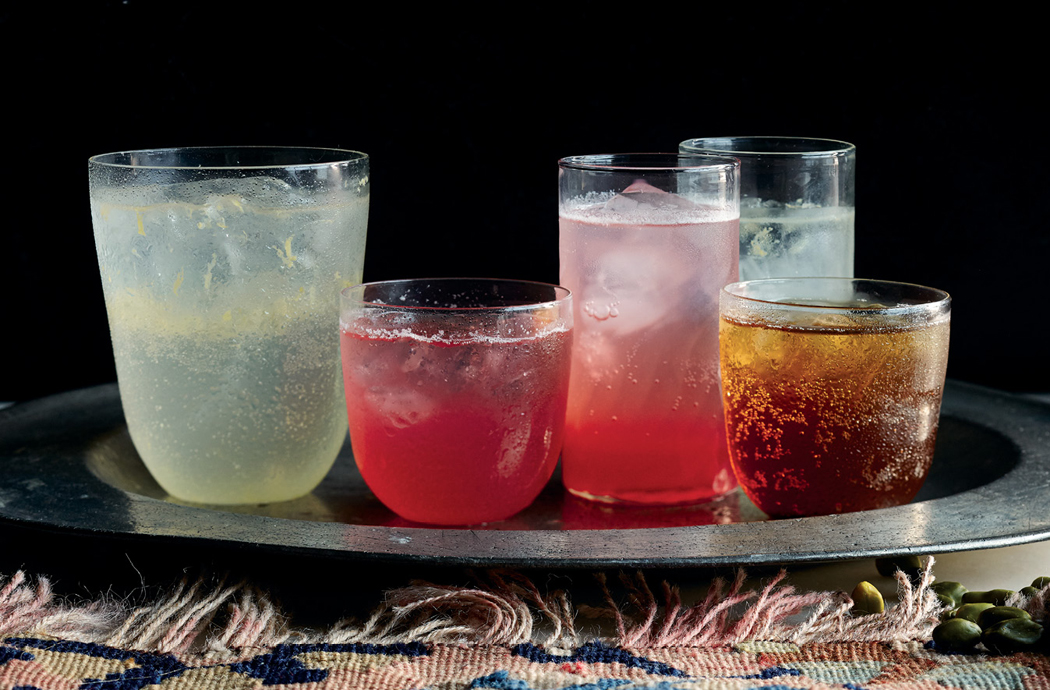
Sharbats, from left to right: Lemon (see recipe), Rhubarb (see recipe), and Tamarind (see recipe).
In Iran and Azerbaijan, syrups are made from fruit juice and sugar cooked down together and flavored with rose water or other aromatics. The syrups are used to make sharbats: diluted with cold water (still or sparkling) and served over ice cubes. A sharbat makes a welcome cooling refreshment in the heat of summer. Since I have a passion for rhubarb, this one, pale pink and tart-sweet, is one of my favorites.
I use less sugar than is traditional; you may want to increase the amount. The lemon juice adds surprising dimension. You can vary the aromatics, by using vanilla sugar, for example, or tossing a vanilla bean into the rhubarb as it cooks instead of using rose water.
Makes about 2 cups; enough for 8 or 9 servings
1½ pounds rhubarb, sliced into approximately ½-inch pieces (about 5 cups)
1 cup water
2 cups sugar, or to taste
3 tablespoons fresh lemon juice
2 teaspoons rose water, or to taste
Place the rhubarb in a nonreactive pot, add the water and sugar, and bring to a boil. Lower the heat and cook at a strong simmer, stirring occasionally, for 20 minutes, or until the rhubarb has disintegrated. You should have about 4½ cups.
Pour the rhubarb into a fine-mesh sieve set over a bowl. Use the back of a large spoon or a spatula to press the rhubarb against the mesh so that the juice is squeezed out. Return the liquid to the pot; set the solids aside for another purpose (see Note). Add the lemon juice and simmer the liquid for 15 minutes to cook it down and concentrate it. Remove from the heat and add the rose water. Transfer the syrup to a glass jar and store in the refrigerator for up to 3 months.
To make sharbat, mix the syrup with cold water, using 3 parts still or sparkling water to 1 part syrup, or to taste. Serve over ice. Float a small sprig of mint or lemon balm on top if you wish.
Note on Rhubarb Sauce: The sweetened rhubarb pulp that remains after you’ve pressed out all the liquid is like a rhubarb version of applesauce, but much smoother on the tongue. Add a dollop to your morning yogurt or to a bowl of ice cream, or spread it on bread or toast like fruit butter.
Tamarind pulp, processed from the fruit of tamarind trees, is now widely available in Asian grocery stores. Often shipped from Vietnam or Thailand, it comes in dark brown blocks wrapped in clear plastic. Tamarind is a wonderfully versatile souring ingredient in savory dishes (see Fried Stuffed Fish, Bushir-Style), and it also makes a delicious sharbat.
Dilute the syrup with cold water or soda water, and serve over ice as a refreshing drink. Or stir it into mascarpone or ice cream. Or try it my favorite way, diluted with hot water to make a warming drink on a cold day.
Makes 2 cups; enough for 10 to 12 servings
1 cup (½ pound) tamarind pulp
2 cups boiling water
2 cups sugar
Cut the tamarind pulp into small chunks, place in a bowl, and pour the boiling water over it. Stir with a fork and set aside to steep for 20 to 30 minutes.
Stir and mash the tamarind with a fork to break it up, then place a fine-mesh sieve over a bowl and pour the tamarind into the sieve. Use the back of a large spoon to press the pulp against the mesh and extract as much liquid and flavor as possible. Discard the coarse pulp in the strainer. You should have about 1½ cups thick liquid.
Transfer the tamarind liquid to a large measuring cup and add enough water to make 2 cups. Pour into a medium nonreactive saucepan and stir in the sugar. Bring to a boil over medium heat, stirring to dissolve the sugar; the mixture will foam up as it boils. Lower the heat to maintain a simmer, partially cover, and cook for 10 to 15 minutes, until reduced to about 2 cups. Cool and store in a glass jar in the refrigerator.
To make sharbat, add 2 tablespoons tamarind syrup to a glass filled with ¾ cup cold water, stir together, and add an ice cube. Taste and stir in a little more syrup if you wish. For a hot drink, use more syrup, about ¼ cup per cup of hot water.
Because lemons are easily available year-round, lemon sharbat is a drink you can make any time. I freely adapted this from a recipe in The Azerbaijani Kitchen by Tahir Amiraslanov and Leyla Rahmanova. Note that you need to steep the lemon zest for at least 5 hours.
Because the zest is used as well as the juice, it’s important to start with organic lemons. The saffron threads are optional, but they give a deeper yellow color to the sharbat.
Makes about 3 cups; enough for 12 servings
6 or 7 organic lemons, scrubbed
¼ teaspoon saffron threads (optional)
1 cup hot water plus 1 cup water
1½ cups granulated sugar
¼ to ½ cup superfine (castor) sugar (optional)
Grate the zest from the lemons into a bowl. (Put the grated lemons in a plastic bag and refrigerate.) Add the saffron threads, if using, and the hot water and stir. Set aside, loosely covered, for at least 5 hours, or as long as overnight.
Pour the lemon zest liquid into a fine-mesh sieve or a cheesecloth-lined colander set over a bowl and discard the solids. Set the liquid aside.
Pour the remaining 1 cup water into a heavy saucepan, add the granulated sugar, and heat over medium heat, stirring to dissolve the sugar. Remove from the heat and set aside to cool to lukewarm.
Meanwhile, juice the lemons and pour the juice into a sieve set over a bowl; discard the pits and pulp. Add the lemon juice and the cooled sugar syrup to the steeped-zest water and stir well. Taste and add the superfine sugar, if desired; stir vigorously to make sure it completely dissolves.
Store in a well-sealed glass jar in the refrigerator.
To make sharbat, place an ice cube in a glass, add ¼ cup of the syrup and ¾ cup cold water, and stir. In winter, this makes a warming, healing hot drink on a cold night: Dilute a generous ¼ cup of the syrup with ¾ cup hot water in a mug and stir in a little honey or add a dash of rum to smooth it out.
Bitter oranges are called naranj in Iran, and originated in Persia.
In the West, our word for oranges comes from the original Persian name. Bitter oranges are sometimes called Seville oranges because they became known to the English via trade with Spain. They are used to make classic orange marmalade, and their peel is the flavoring in orange bitters and in a number of other dishes.
Until recently, bitter oranges were available for only a few weeks in the winter. But they are now being grown in California, so it’s easier to find them and they are available for longer: late January until late March or early April. They are a little wild looking: bumpy and irregular shaped, with lots of seeds and often not a lot of juice. The juice they do have is precious. Use it in salad dressing in place of lemon or lime juice, or drizzle it on grilled fish or roasted chicken. Or use it to make this orange syrup, the base for a delicious sharbat that is citrusy and reminiscent of old-style lemonade, but with a generous orange undertone.
Makes about 2½ cups; enough for 8 or 9 servings
5 bitter oranges
1 cup water
2 cups sugar
Cut the oranges in half and juice them. Pour the juice through a fine-mesh strainer set over a bowl and discard the pulp. You should have a scant 1 cup juice. Set aside.
Fill two 1-cup jam jars with hot water and set aside.
Place the water in a nonreactive saucepan, add the sugar, and stir with a wooden spoon until the sugar is completely dissolved. Bring to a boil, add the orange juice, and bring back to a boil, then reduce the heat and simmer for 5 minutes. Remove from the heat. Empty the jars of water and pour in the syrup. Cover tightly and, once cooled, store in the refrigerator for up to 3 months.
To make sharbat, place an ice cube in a glass, add ¼ cup syrup and ¾ cup cold water or sparkling water, and stir.
There are many ways of eating a pomegranate, but my favorite is the way I learned in Iran, watching a Khamseh nomad man in the mountains east of Shiraz (see Nomad Encounter).
Here’s his method: Pomegranates are full of juicy seeds held in place by bitter pith, and when the fruits are ripe and fresh, sucking the juice is the easiest and best way to eat them. Start by holding the pomegranate in your hands and squeezing it all over, pressing on it with your fingertips all over until it goes from being a tight-skinned fruit to feeling very soft. Feel for any firm places and press on them.
Poke a small hole in the fruit and immediately put your mouth over the hole and start swallowing the juice (it will spurt out if you’re not careful). Suck and swallow some more. Keep pressing on the fruit as you suck, and keep rotating it around. The pressing breaks up the seeds, releasing their juice. As you continue to suck, the fruit will get more and more like a basketball that has lost its air, with dents and hollows and softness. Eventually, when it is very saggy, you can break the pomegranate open. Inside, the seeds will be a pale pink, having had their juice pressed and sucked out of them. There may be the odd renegade still-red seed or two; those you can eat one by one. At the end of the process, your pucker muscles will be a little tired, but you’ll have had a delicious drink of fresh pomegranate juice without having had to deal with the messiness of the seeds and pits and membranes.
To gather pomegranate seeds for use in recipes, my usual method is one I saw used by home cooks in Iran: Put out a bowl for the seeds. With a sharp knife, carefully cut a small—say, 1 inch—triangular piece out of the skin near the top and lift it off. Gently pull the seeds off the piece and put them in the bowl. Cut a second small piece and repeat. After that, you can pull the fruit apart, carefully, into several large fragments. Work with one piece at a time, gently detaching the seeds and letting them drop into the bowl. After you’ve finished, go through the seeds and discard any fragments of bitter white pith.
To squeeze a pomegranate for fresh juice, place it in a ziplock bag and roll it on a hard surface, pressing down firmly. Make sure you press on it all over. If the pomegranate splits, the juice will leak into the bag. If it doesn’t, take it out of the bag and hold it over a bowl while you make a hole in the skin: The juice will start pouring out. Squeeze the fruit with your hands to press out more juice. Alternatively, you can remove the seeds as described above, clean off the pith, and process them in a blender or processor to break them down and release their juice. Place a sieve over a bowl, pour the blender contents into the sieve, and press on the solids to extract more juice. Discard the solids.
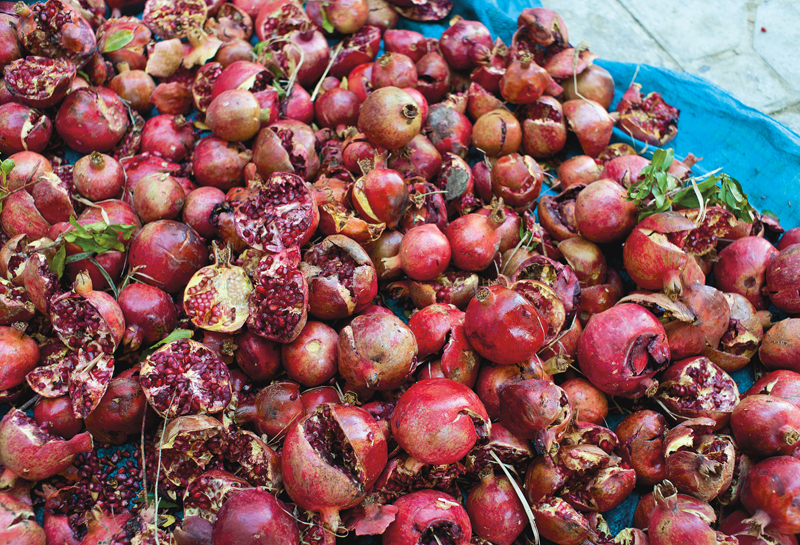
Two hours west of Yazd, Iran—Ripe pomegranates for sale by the side of the road in a small hamlet. I bought a bagful of them and then ate them the nomad way (see here) over the next few days. They were the best pomegranates I have ever tasted.
Pomegranate molasses, also known as pomegranate syrup, is a concentrated, cooked-down version of pomegranate juice. Anar is the word for pomegranate in Persian and in most of the languages of the Persian culinary region. The word robb has traveled far. It’s from Persian, and is also found in Georgian, Armenian, and Azeri, as well as in Kurdish. It came into English as rob, an old word that probably traveled to England after the Crusades, and old English cookbooks have recipes for various robs.
Many kinds of robb were on sale in the village of Massouleh, near the Caspian, when I was there, being bought by eager tourists from other parts of Iran. But pomegranate molasses is the most widely used version of robb: A dash of it adds a tart-sweet depth to soups and stews (it is often used in Persian ash dishes; see recipe), and it’s also the basic flavoring in fesanjun (see recipe).
Now that bottled pomegranate molasses (see Glossary) is widely available in North America, it’s no longer necessary to make it at home. But if you’d like to taste the homemade version, here are the instructions for making it.
It takes about 6 cups of pomegranate juice to make 1½ cups of molasses. Pomegranates vary from sweet to tart. Most juice available in North America is from sweet pomegranates.
Makes just under 1½ cups
6 cups pure unsweetened pomegranate juice
Up to ¼ cup sugar (optional)
2 tablespoons fresh lemon juice (optional)
Place the pomegranate juice and sugar, if using, in a wide heavy pot. Bring to a boil, stirring if using sugar, and then cook for about 25 minutes at a medium boil. After about 20 minutes, you will notice that the volume is starting to decrease. Lower the heat and start stirring the molasses with a wooden spoon to prevent it from sticking. As it thickens, the syrup will have big smooth bubbles. Keep cooking until it has reduced to about 1½ cups, about another 20 minutes. (As the syrup cools, it will thicken further.) Taste it; the syrup should be tart and intense. If you like, you can increase the tartness by stirring in the lemon juice before you take it off the heat.
Pour into clean dry jars, seal, and store in the refrigerator for up to 1 month.

It’s impossible to imagine a feast in Georgia or Armenia without wine. Wine, both red and white, has been part of the culture in both countries for millennia. (And since the arrival of Christianity in both countries in the fourth century, red wine has been the wine of the communion service.) There are many wineries in Georgia, but most often if you are eating at someone’s house, you will be drinking wine that your hosts or someone in their family made.
Grapes are native to the Caucasus, and there are hundreds of varieties of wine grapes in the region, many of them very old. In Georgia, the best-known grape for red wine is the Saperavi. Whites include Kisi, Khikhvi, Rkatsiteli (also grown in Azerbaijan), and Tsolikouri. The grapes are used to make both “natural” wines and European-style barrel-aged wines.
It’s only recently that people outside Russia have had any contact with wines from the Caucasus. The wines were sold locally and to the Russian market (although Armenian brandy had a following in the West). Collectivization of vineyards and industrial-style winemaking were imposed by the Soviet authorities in the 1930s. Many grape vines were torn up in the 1980s when Gorbachev, then leader of the USSR, declared drunkenness a huge problem and restricted wine production and sales.
In the last thirty years, some local wineries and small winemakers have returned to traditional, more labor-intensive methods of winemaking, known as “natural” winemaking, which families had long used for making household wine for their own consumption. Wines from Georgia and Armenia, and from Azerbaijan too, are now finding markets in the rest of the world, and production of both natural wines and more Western-style wines has grown. Natural winemaking has become a fashion in other places, and natural wines now have a niche market.
Kvevris, large clay amphorae that are kiln-baked and lined with beeswax, are the essential tools of Georgian and Armenian makers of traditional wines. The Armenian word for kvevri is karas. The kvevris used for fermentation, when the must (grape liquid) sits with the mash, hold from 1,000 to 3,000 liters. They are buried in the ground, which keeps the temperature of their contents stable and cool enough for controlled fermentation. The grapes are pressed (traditionally by being trod on by a crowd of young people), and the pressed juice is stored with some of the mash (skins, seeds, and stems) in the kvevri to ferment for some months under a sealed lid (with a small pipe to vent carbon dioxide). The debris all sinks to the narrow bottom point of the kvevri, leaving the liquid clear. No additives are used in the red wines; the whites, which are a pale orange rather than white, do have added sulfites to stabilize them. After the early fermentation, the wine is transferred to smaller kvevris for aging.
Georgia’s best-known wine region is in the east, in Kakheti, but western Georgia is now producing interesting wines too. In Armenia, most grapes are grown in the fertile, sheltered Arax River Valley and on the slopes above it. Other fruits are also used to make wines in Armenia. In the summer and fall months, the road near the village of Areni, east of Yerevan, is lined with small stands selling homemade fruit wines and liquors, as well as fruits and vegetables.
As in other wine-producing regions, the Georgians make a distilled drink from the fermented grape mash (like marc in France or grappa in Italy). The Georgian word is cha-cha, which is also the term for the fermented mash. Armenian brandy, distilled from fermented grape pressings, is made in a distillery in Yerevan.
Though Azerbaijan is a Muslim country, its wine industry is growing. European-style wines are produced from grapes grown in the Caucasus foothills and in the Kura River Valley near the inland city of Ganja. As in Georgia, many indigenous varieties of grapes are grown, as well as European varieties such as Pinot Noir.

Tatev, Armenia—Three generations of a family were cooking gallons of tomatoes over a fire in their backyard when I walked by their house in this small hilltop village one sunny day. One of the brothers invited me to drink tutovka with them. Here they’re making a toast to friendship.
The climate in the Persian culinary region suits all kinds of fruit trees, including mulberries. And in places in the Caucasus, there are still enormous mulberry orchards, remnants of a time when people living near the mountains raised silkworms; the fresh leaves would be gathered in huge piles to feed the worms. I met a man of about fifty in Sheki, Azerbaijan, who remembered gathering mulberry leaves when he was a child.
The Silk Museum in Tbilisi gives some idea of how complex, and also how beautiful, the process of raising silkworms used to be. It was a domestic industry; individual households raised silkworms and sold the thread to silk factories, where it was woven into fabrics and rugs. There is still a silk factory in the town of Sheki and orchards of mulberry trees in the valley below the town. But these days, rather than using locally raised silk, the factory imports it from Uzbekistan and, increasingly, from China.
Mulberries are called tut, or tuta, in Persian, Kurdish, Armenian, Georgian, and Azeri. They are black, shaped a little like long raspberries, but with a much firmer texture. They are tart-sweet and delicious, and can be eaten fresh, but they are most often dried. They are used in savory dishes in the same way dried barberries are, to add a tart note, but their primary use is for liquor. They are fermented and distilled in village homes to make tutovka (mulberry vodka), a clear spirit that can be delicious. People in the Caucasus drink it as they do vodka, chased by a glass of fruit juice.
Which came first in the region, mulberry fruit for distilling or the mulberry leaves as food for silkworms? The Encyclopedia Iranica says that in Aramaic, the ancient language spoken in Darius’s Persian Empire, and still by modern-day Assyrians, the word for mulberry is twt. That’s persuasive evidence that mulberries have been in the region for millennia, and that people have likely been making drinks from mulberries since before the time of the Persian Empire. The silkworms came later.